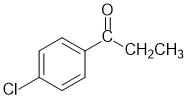Part 8: SPECTROSCOPY
The following data is available from the
question.
Note
: Remember to cross
reference things to confirm.... e.g.
IR may show C=C, use NMR to
confirm that etc.
MS: M+
seen at 168 g/mol, with an m+2 pattern of 3:1 intensity that implies Cl.
IR:
There is a strong absorption at about 1700 cm-1 which is probably a C=O (note a little low for a ketone) and maybe around 1600 cm-1 which is probably C=C. There are no other absorptions of note.... no OH, NH, C≡C or C≡N.
13C NMR:
The normal proton decoupled spectrum shows a total of 7 peaks indicating 7 types of
C. By analysis of the chemical shifts, we have a peak at 200 ppm (C=O in the aldehyde / ketone range), 4 peaks between 125-145 ppm (4 types of ArC) and peaks at 32 & 9 ppm that are
most likely from sp3 C hydrocarbon fragements.
1H NMR:
The proton spectrum shows a total of 4 sets of peaks indicating 4 types of H.
|
d/ppm
|
multiplicity
|
integration
|
Inference
|
|
7.8
|
d
|
2
|
ArH 2 x CH coupled to H |
| 7.5 |
d
|
2
|
ArH 2 x CH coupled to H |
|
2.9
|
q
|
2
|
CH2 coupled to 3H, slightly deshielded |
| 1.2 |
t |
3 |
CH3 coupled to 2H |
(dq = doublet of quartets, dd = doublet of doublets, q = quartet, t = triplet, d = doublet, s = singlet)
The most significant structural information
from this are:
- adding integrals shows 9H (or a multiple thereof)
- it has a disubstituted aromatic (benzene)
- there are coupling patterns to decipher
Summary....
The MS indicated MW = 168 and Cl.
The IR showed the presence of C=O
13C NMR shows 7 C types including C=O that is most likely an aldehyde or ketone. Since there is no -CHO in the HNMR (9-10 ppm), it can not be an aldehyde.
H NMR gives -CH2-, -CH3, and C6H4 (disubs. benzene)
This information suggests an initial molecular formula = C9H9OCl
which gives MW = (9x12) + (9x1) + 16 + 35 = 168 (matches the MS)
Therefore, molecular formula = C9H9OCl and has an IHD = 5 consistent with the C=O and benzene.
Altogether...
|
The fragments we have are:

The IR, 13C and molecular formula imply that the C=O carbonyl is part of an ketone.
The H-NMR 2H quartet at 4.2 ppm and 3H triplet at 1.2 ppm indicate an ethyl group, -CH2CH3.
The IR, 13C and molecular formula imply that the C=O carbonyl is part of an ketone which therefore must be btween the ethyl group and benzene:

All that is left to do is establish the regiochemistry of the Ar region which is most easily done from the NMR. 4 types of ArC and 2 types of ArH as "doublets" implies a para- system, giving us the structure... |

p-chloropropiophenone
|
The final step should always be to check what you
have drawn. The easiest thing to check is usually the coupling patterns you
would expect to see, and the chemical shifts of each unit. You should
be asking yourself : "Does my answer give me what the H-NMR shows ?"
Common errors:
MS incorrectly read the MW for the identified M+ (check the scale), missed or incorrect halogen.
13C NMR ignored the specifics of the C=O range (i.e. subtype : 200 ppm > 190 therefore it's a aldehyde or ketone).
H NMR had hydrocarbon pieces that did not fit the integration and coupling patterns.
General
- did not check MW with data from MS
- wrong type of C=O (look at 13C NMR C=O range and check IR frequency)
- did not check HNMR integration for number of H on the aromatic and hence had incorrect substitution of the benzene.
![[Home]](../mol.gif)



![[Home]](../mol.gif)